April 1946
| << | April 1946 | >> | ||||
|---|---|---|---|---|---|---|
| Su | Mo | Tu | We | Th | Fr | Sa |
| 1 | 2 | 3 | 4 | 5 | 6 | |
| 7 | 8 | 9 | 10 | 11 | 12 | 13 |
| 14 | 15 | 16 | 17 | 18 | 19 | 20 |
| 21 | 22 | 23 | 24 | 25 | 26 | 27 |
| 28 | 29 | 30 | ||||
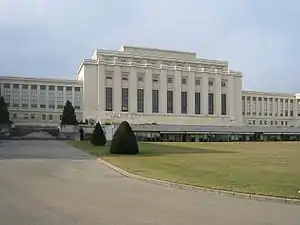
April 18, 1946: The League of Nations closes after 27 years
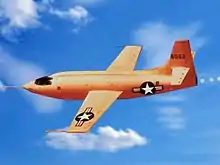
April 11, 1946: The rocket plane X-1-1 makes its first flight
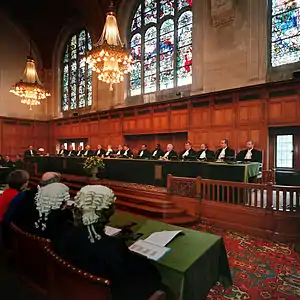
April 18, 1946: The United Nations World Court opens
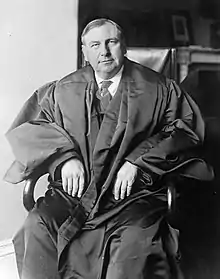
April 22, 1946: U.S. Chief Justice Stone suffers fatal stroke during proceedings
The following events occurred in April 1946:
April 1, 1946 (Monday)
- A tsunami, generated by an 8.6 magnitude earthquake near Alaska, killed 159 people in Hawaii. Waves 25 feet high struck Hilo shortly after 7:00 am local time, and almost five hours after the Alaskan tremor.[1]
- Bituminous coal miners walked off the job across the United States, as 400,000 UMWA members went on strike in 26 states.[2] The miners returned to work after six weeks.
- As part of Operation Road's End, the United States Navy destroyed and sank 24 Japanese submarines that had been surrendered at the end of World War II. Twenty-three were blown up with demolition charges. The I-402, which had sunk the USS Indianapolis, was destroyed by shellfire.[3]
- The United Kingdom made Singapore a Crown colony, separating the predominantly Chinese population from the rest of the Union of Malaya.[4]
- The United States Supreme Court declined to grant certiorari on an appeal from the 5th Circuit Court of Appeals in Chapman v. King, et al. 154 F.2d 460 (5th Cir. 1946), which held that African-Americans could not be barred from voting in primary elections in Georgia. At the time, the Democratic Party was the dominant political party in Georgia and other Southern states in the Fifth Circuit, and the winner of the Democratic primary was frequently unopposed in the general election. Primus E. King of Columbus, Georgia, had commenced the suit in 1944, to challenge the practice of allowing political parties to set their own rules concerning who would be allowed to vote in a nominating election. The decision paved the way for allowing Black Americans to vote in primary elections in other states.[5]
- Born: Robert Garwood, U.S. Marine and Vietnam POW, who was convicted in 1981 of collaboration with the enemy; in Greensburg, Indiana
- Died:
- Noah Beery, Sr., 64, American film actor
- Edward Sheldon, 60, American playwright
April 2, 1946 (Tuesday)
- In Japan, General Douglas MacArthur, administrator of the American occupation, issued the first regulations against fraternization between American soldiers and Japanese citizens. Originally intended to stop soldiers from consorting with prostitutes, the regulations soon provided for segregation in public transportation, food service and accommodation, with Japanese residents being barred from American facilities, and vice versa.[6]
- Japanese storekeeper Katsumi Yanagisawa began the business of manufacturing music stands, which grew into the Pearl Musical Instrument Company, and eventually became Pearl Drums.[7]
- Born: Yves "Apache" Trudeau, Canadian murderer alleged to have killed 43 people for the Hells Angels group.[8]
- Died: Kate Bruce, 88, American silent screen actress
April 3, 1946 (Wednesday)
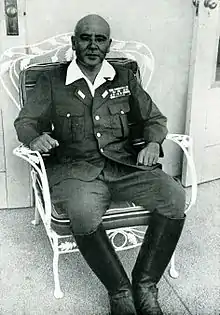
General Homma
- An article, on the front page of the Amsterdam newspaper Het Parool, brought the attention of publishers to the existence of a diary, written by a teenage girl who had died in a Nazi concentration camp. Historian Jan Romein wrote, under the headline "Kinderstem" ("A Child's Voice"), "[T]his apparently inconsequential diary by a child ... stammered out in a child's voice, embodies all the hideousness of fascism, more so than all the evidence at Nueremberg put together." Published in the Netherlands as 1947 as Het Archterhuis: Dagboekbrieven ("The Attic: Diary Notes"), the book would be translated into English in 1952 as Anne Frank: The Diary of a Young Girl.[9]
- Died: Lt.Gen. Masaharu Homma, Japanese general who ordered the Bataan death march, was executed in Manila by a U.S. Army firing squad.[10]
April 4, 1946 (Thursday)
- The eleven nation Far Eastern Commission exempted Japan's Emperor Hirohito from being tried for war crimes.[11]
- Nine U.S. Navy personnel, from the aircraft carrier USS Tarawa, were killed while watching training exercises from an observation tower in Puerto Rico. One of the airplanes inadvertently released a bomb which made a direct hit on the tower.[12]
- Born: Dave Hill, English guitarist (Slade), in Holbeton
April 5, 1946 (Friday)
- After almost a full year of Russian occupation Bornholm was liberated.
- The Soviet Union and Iran announced a 25-year agreement to create a "Soviet-Persian Oil Company", with the U.S.S.R. to have 51% of Iran's oil rights in return for the withdrawal of Soviet troops.[13] However, the treaty, subject to the approval of Iran's Majlis, was rejected in 1947.[14]
- By a 41–27 margin, the United States Senate approved increasing the 40¢/hour minimum wage to 65¢ per hour.[15]
- Thirty-six years after it had been written, Charles Ives's Third Symphony was given its first public performance. In 1947, Ives would win a Pulitzer Prize for the 1910 symphony.[16]
- A Fleet Air Arm Vickers Wellington, HE274, crashed into a residential area in Rabat, Malta during a training exercise, killing all 4 crew members and 16 civilians on the ground.[17][18][19]
- Born: Björn Granath, Swedish actor, in Gothenburg
- Died: Vincent Youmans, 45, American songwriter
April 6, 1946 (Saturday)
- Captain Hoshijima Susumu, Japanese commander of the Sandakan prisoner-of-war camp in Indonesia, was hanged for war crimes. Capt. Hoshijima had ordered the "Sandakan Death Marches" as the war approached a close in 1945. During his administration, nearly 6,000 prisoners died—4,000 Indonesians, 1,381 Australians and 641 British.[20]
- Acting on a tip from a geisha house, American officials unearthed two billion dollars worth of gold, silver and platinum that had been hidden in the muddy bottom of Tokyo Bay. An officer of the Japanese Army had carried out the concealment of the precious metals in July 1945, shortly before the surrender of Japan.[21]
April 7, 1946 (Sunday)
- Free elections were conducted in Milan for the first time since 1922, when Benito Mussolini had installed a Fascist regime, and 800,000 ballots were cast in voting for local councilmen.[22]
- Born:
- Colette Besson, French athlete, 1968 Olympic gold medalist in the 400 m race; in Saint-Georges-de-Didonne (d. 2005)
- Zaid Abdul-Aziz, American NBA player, as Donald A. Smith in Brooklyn
- Léon Krier, Luxembourgian architect
April 8, 1946 (Monday)
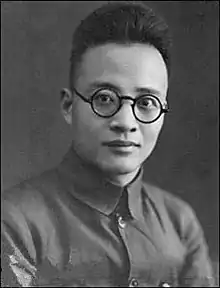
Qin Banxian
- In Geneva, the League of Nations, predecessor to the United Nations, opened its final session.[23]
- The Fort Wayne Zollner Pistons, who would later become the NBA's Detroit Pistons, won their third consecutive World Professional Basketball Tournament, defeating the Oshkosh All-Stars 73-57 to win the third and final game of the best-of-three series.[24]
- Two iconic films of 1946, Frank Capra's It's a Wonderful Life and William Wyler's The Best Years of Our Lives, began filming on the same day.[25]
- Électricité de France (EDF) was created, as the French government nationalized the electric industry in that nation, formerly handled by more than 1,450 firms.[26]
- Ethiopian Airlines, now one of the largest airlines in Africa, began its first service, with a flight between Addis Ababa and Cairo.[27]
- Born:
- Robert L. Johnson, the first African-American billionaire and founder of Black Entertainment Television (BET), in Hickory, Mississippi
- Jim "Catfish" Hunter, American MLB pitcher, in Hertford, North Carolina (d. 1999)
- Died: Qin Bangxian, 39, General Secretary of the Communist Party of China 1932–35, Ye Ting, Bo Gu, Deng Fa and others in a plane crash while en route from Chongqing to Yan'an.[28]
April 9, 1946 (Tuesday)
- The Montreal Canadiens won the Stanley Cup, defeating the Boston Bruins 6–3 to win the series in five games.[29]
- Angkatan Udara Republik Indonesia (AURI), the Indonesian Air Force, was formally established, drawing primarily from a fleet of about 50 captured Japanese airplanes.[30]
- The University of Bergen was founded in Norway.[31]
April 10, 1946 (Wednesday)
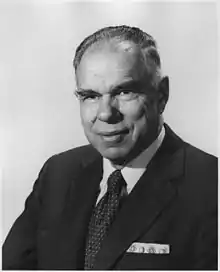
Seaborg
- In Japan's first multiparty election since 1932, women were allowed to vote for the first time as 2,770 candidates vied for 464 seats in the House of Representatives of Japan. The Liberal Party, led by Ichirō Hatoyama, won 142 seats, followed by the Progressive Party (94) and the Japanese Socialist Party (92), but Hatoyama was not allowed by the Allied occupation authorities to serve, as Prime Minister, because of prior service in the enemy government.[32]
- The Federal Communications Commission approved the first expansion of long distance telephone calling since before World War II, as AT&T was granted the right to add 1,000 new phone circuits.[33]
- At the annual meeting of the American Chemical Society in Atlantic City, Dr. Glenn T. Seaborg announced the names for the two newest elements which had been created in 1946 at the University of California. Element 95 was dubbed americium and Element 96 was curium.[34]
April 11, 1946 (Thursday)
- The French National Assembly passed a resolution sponsored by deputy Félix Houphouët-Boigny of the Ivory Coast, finally outlawing the practice of "forced labor", in France's overseas territories. Until that time, it was permissible for the colonial government to require adult males in the African colonies to work on government projects, without remuneration, for a set number of days in each year. On the island of Madagascar, Malagasy men had to labor a minimum of fifty days on colonial projects.[35] Houphouët-Boigny, for whom the "Loi Houphouët-Boigny" was named, would become the first President of the Ivory Coast in 1960.
- The Bell X-1 experimental jet airplane made its first powered flight, with Chalmers "Slick" Goodlin taking the first of the three prototypes, X-1-1, on a flight from the Muroc Army Air Field. The X-1-1 had first been glide-tested on January 25, 1946. On October 14, 1947, Chuck Yeager would fly the X-1-1 at faster than the speed of sound.[36]
April 12, 1946 (Friday)
- British war hero Harold Alexander, 1st Earl Alexander of Tunis, took office as the 17th Governor General of Canada, serving until 1952.[37]
- The Goodyear Tire and Rubber Company announced its plans to build dirigibles that would carry up to 300 passengers on overseas trips in the same manner as an ocean liner.[38] None were ever put into service.
- Born: Ed O'Neill, American TV actor known for Modern Family and Married... with Children; in Youngstown, Ohio
- John Dunsworth, Canadian TV Actor (Trailer Park Boys)
- Died: "Chips", 6, mixed breed dog who was awarded the Purple Heart and the Distinguished Service Cross for combat during World War II (both were later rescinded); of kidney failure.[39]
April 13, 1946 (Saturday)
- A group of Jewish employees at a bakery in Nuremberg placed arsenic on the bottom of thousands of loaves of bread to be delivered to a prisoner-of-war camp housing former members of the German SS.[40] In all, 2,283 SS men at Stalag 13 became ill, none fatally, in the week that followed.[41]
- In France, the "Loi Marthe Richard" took effect, and the system of government-regulated houses of prostitution came to an end. The 1,400 brothels, including 200 in Paris, were closed.[42]
- "Arzamas-16" was established by the Soviet government at the site of the Russian town of Sarov, as a secret center for the construction of nuclear weapons.[43]
- British Prime Minister Clement Attlee authorized Sir Stafford Cripps, the leader of the Cabinet Mission to British India, to agree to the partition of the colony into separate nations. The predominantly Hindu provinces became the Dominion of India, while the mostly Muslim provinces became the Dominion of Pakistan (and, later, Pakistan and Bangladesh).[44]
- Rikichi Andō, the last Japanese Governor-General of Taiwan, was captured by Nationalist forces and charged with war crimes. He committed suicide one week later.[45]
- Born: Al Green, American soul and gospel singer, in Forrest City, Arkansas
- Died: Miss Elsie Marks, who worked in carnivals for 20 years as the "Cobra Woman", after being bitten by a diamondback rattlesnake during a performance in Long Beach, California. Her autopsy confirmed that the Cobra Woman had been a man, Alexander Marks.[46]
April 14, 1946 (Sunday)
- Sh'erit ha-Pletah members of Nakam, the "Jewish Avengers", carried out a plan to poison as many former members of Hitler's SS. After the war, thousands of former SS men were detained at Stalag XIII-D in Nuremberg. When the avenging group learned that most of the bread supplied to the prison camp came from a single bakery, one of the group's members, Arye Distel, obtained a job as an apprentice baker. Over a period of several days, Distel smuggled bottles of arsenic fluid into the bakery and, on April 13, he and four other members brushed the poison on 3,000 loaves of bread to be delivered to Stalag XIII-D. "How many of those SS men actually died following the poisoning at Stalag 13 has never been verified,", The Guardian would report more than 60 years later, "but some put the figure at several hundred, others at a thousand." [47]
- Chinese Communist leader Zhou Enlai announced the beginning of a war against the Nationalist government of Chiang Kai-shek, one day after Soviet troops had withdrawn from Manchuria.[48] The Communist forces attacked Changchun on the same day and captured it by April 17.[49]
April 15, 1946 (Monday)
- The first television network was created, as the DuMont Television Network linked New York and Washington by coaxial cable. A two-hour program featuring speeches, "along with a short play, a quiz show, and a dance routine" were broadcast simultaneously on both stations.[50]
- Frozen concentrated orange juice was first put on sale, by Florida Foods Corporation, as shipments arrived from a plant in Plymouth, Florida, under the name "Minute Maid"[51]
- Production began of the first Nikon cameras. The Japanese Optical Company (Nippon Kogaku) had manufactured lenses since 1917.[52]
- For the first time since 1933, the Jewish observance of Passover was legally held in Germany.[53]
- The United States Army revealed the existence of its previously secret night vision device, the "Snooperscope", which had been used by Army snipers during the Second World War.[54]
- The daily comic strip Mark Trail, created by Ed Dodd and showcasing the adventures of a park ranger, made debut, syndicated by the New York Post.[55]
- Died: Thomas Dixon, Jr., 92, American author
April 16, 1946 (Tuesday)
- The United States made its first successful launch of a V-2 rocket, captured from Germany and tested at the White Sands Proving Ground. In all, 63 were fired for various purposes as part of American development of its own missile program.[56]
- The mining firm Western Holdings Lts. announced the discovery, at Odendaalsrus of the richest gold vein ever found in South Africa, setting off the first gold rush since before World War II. The yield was 62 ounces per ton, compared to 1/4 ounce per ton in most South African ore.[57]
- Baseball Commissioner A.B. Chandler announced a five-year suspension of any American players who broke their contracts to sign with Jorge Pasquel's Mexican League. Twenty major leaguers had been signed away after Pasquel attempted to compete against the American and National Leagues.[58]
- In the eight opening games for the 16 major league teams, a record 236,730 turned out. Among 18,261 who watched the Boston Braves beat the visiting Brooklyn Dodgers, 5–3, more than 300 discovered that they had been sitting in wet paint.[59]
- The world learned for the first time of a coal mine disaster that had killed 1,549 miners—mostly Chinese and Korean, laboring for a Japanese company – four years after it had happened. The April 16, 1942, explosion had been kept secret, even from the Tokyo government, by Japanese military officials.[60]
April 17, 1946 (Wednesday)
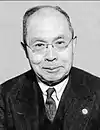
American selection Shidehara

Hatoyama, barred from serving
- In the first large scale protest against American occupation since Japan's 1945 surrender, an estimated 200,000 Japanese demonstrators marched in Tokyo in protest against the U.S.-selected Prime Minister, Kijūrō Shidehara. The SCAP occupation sent in U.S. soldiers to disperse the crowd.[61]
- Syria's independence from France was made complete with the withdrawal of the last occupying forces from that nation. April 17 is still recognized as "evacuation day".[62]
- The Western film The Virginian starring Joel McCrea, Brian Donlevy, Sonny Tufts and Barbara Britton was released.
- Died: Jack Quinn (baseball), 62, American baseball player 1909–1933, and one of the last three who could legally throw a "spitball"
April 18, 1946 (Thursday)
- The 34-member League of Nations, in its last meeting, transferred its assets to the United Nations and disbanded at midnight Geneva time (2300 GMT).[63]
- The International Court of Justice, established by the United Nations and often referred to as the World Court, held its first meeting, assembling at The Hague.[64]
- The United States gave full diplomatic recognition to the government of Josip Broz Tito in Yugoslavia.[65]
- Twelve coal miners near Radford, Virginia, were killed in a methane explosion.[66] 4/19
- Jackie Robinson made his debut in "organized baseball", appearing for the minor league Montreal Royals after having played for the Kansas City Monarchs in the Negro American League.
April 19, 1946 (Friday)
- The Constituent Assembly of France voted 309–249 to approve a new Constitution for what would be called the "Fourth Republic", subject to approval at a referendum set for May 5, under which a unicameral legislature would replace the existing Senate and Chamber of Deputies.[67]
- Belmont, West Virginia, and Farmers Branch, Texas, were both incorporated as cities.
- Born: Tim Curry, British actor, vocalist, and composer, in Grappenhall
- Died: Walter Dandy, 60, pioneering American neurosurgeon
April 20, 1946 (Saturday)
- The Anglo-American Committee of Inquiry issued its recommendations on the future of Palestine, including allowing up to 100,000 Jewish refugees from Europe to be resettled in the area, but barring a Jewish state.[68]
- The residents of Lake Success, New York, a village on Long Island, voted 118–70 to temporarily house the headquarters of the United Nations, at the old Sperry Gyroscope Company plant.[69]
- Stylianos Kyriakides won the Boston Marathon.[70]
- Born: Julien Poulin, Canadian actor, in Montreal
- Died: Mae Busch, 54, American film actress in the Laurel and Hardy comedies
April 21, 1946 (Sunday)

Keynes
- The Socialist Unity Party of Germany (Sozialistische Einheitspartei Deutschlands or SED), with one million members, was created in the Soviet zone of Germany (later East Germany by the merger of the Communist Party and the Social Democratic Party. The SED would govern East Germany from 1946 until 1990.[71]
- The Columbia Broadcasting System (CBS) made the first successful transmission of its system of color television, in a format that could be received by both black-and-white and color television sets.[72]
- Died: John Maynard Keynes, 62, British economist for whom Keynesian economics is named
April 22, 1946 (Monday)
- Harlan Fiske Stone, the 73-year-old Chief Justice of the United States, was announcing his dissenting opinion in the case of Girouard v. United States, when he had the onset of a stroke. Stone was taken by ambulance to his home and died of a cerebral thrombosis that evening.[73]
- John F. Kennedy, the 28-year-old son of former U.S. Ambassador to Britain Joseph P. Kennedy, announced his candidacy for the U.S. House of Representatives.[74]
- A woman in Bacacay, Brazil, was reported to have given birth to two boys and eight girls, an item listed under "Highest number at a single birth" in The Guinness Book of Records.[75]
April 23, 1946 (Tuesday)
- Manuel Roxas was elected as the first President of the Third Republic of the Philippines, as well as the last President (equivalent to Governor) of the Commonwealth of the Philippines, defeating incumbent Sergio Osmeña in advance of scheduled independence.[76]
- The patent for the first Vespa motor scooter was filed, by the Italian company Societa Rinaldo Piaggio. Inexpensive, reliable and fast, the Vespa soon became popular worldwide.[77]
- Grave robbers in Milan stole the remains of Benito Mussolini from an unmarked pauper's grave.[78] The body, taken by admirers of Italy's Fascist dictator, was located on August 12 at a monastery in Pavia.[79]
- The Eastern Pennsylvania Basketball League, which went on to become the minor league Continental Basketball Association, was founded. The CBA played for 64 seasons before folding in 2009.[80]
- A 19-year-old sailor, on the U.S. Navy tank landing ship USS LST-172, shot to death nine of his shipmates before being overpowered. Seaman 2nd class William Vincent Smith made the attack while the boat was cruising on the Yangtze River.[81] Smith hanged himself in jail on August 2, 1947, while awaiting a court martial.[82]
- Howard Hughes's Western movie The Outlaw (US, 1943), starring Jane Russell, went on general release.
- Ed Head of the Brooklyn Dodgers pitched a 5–0 no-hitter against the Boston Braves at Ebbets Field.[83]
April 24, 1946 (Wednesday)
- In the United States, the Blue Angels stunt flying team was formed by the U.S. Navy.[84]
- In the Soviet Union, two new fighter jets—the MiG-9, flown by Alexei Grinchik, and the Yak-15, piloted by Mikhail I. Ivanov—both flew for the first time. A coin toss determined that the MiG was allowed to take off first.[85]
- In France, the Constituent Assembly voted 487 to 63 to nationalize the insurance industry, taking over fifty large companies.[86]
April 25, 1946 (Thursday)
- Forty-seven people were killed and 127 injured in a railroad accident at Naperville, Illinois, when the Burlington Railroad's "Exposition Flyer" crashed at 1:06 pm (CST) into the same line's "Advance Flyer", which had stalled after an earlier departure from Chicago.[87]
- A Marian apparition, wherein observers see the Virgin Mary appear before them, was first reported to have happened near the Bavarian village of Marienfried. The Virgin's appearance was repeated on May 25 and June 25, and the shrine of "Our Lady of Marienfried" was established.[88]
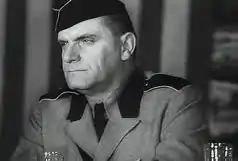
American Fuehrer Kuhn
- Fritz Kuhn, the would-be American fuehrer who led the Nazi German American Bund, was released from an internment camp in his native Germany, after American authorities concluded that he no longer posed a threat to security.[89]
- A general election was held in Southern Rhodesia, the first since the Second World War. The United Party of Prime Minister Godfrey Huggins lost its overall majority but remained in power.
- Born:
- Talia Shire, American actress, in Lake Success, New York
- Strobe Talbott, American foreign policy analyst, in Dayton, Ohio
- John Fox, British statistician
- Vladimir Zhirinovsky, Russian politician and leader of Russia's Liberal Democratic Party; in Alma-Ata, Kazakh SSR, Soviet Union
April 26, 1946 (Friday)
- The port of Harbin, tenth largest city in China, was taken over by Chinese Communist forces without incident.[90]
- The town of Pemberton, Minnesota, was incorporated.
- Born: Marilyn Nelson, American poet, in Cleveland
April 27, 1946 (Saturday)
- The "Whirlaway", the first successful helicopter to have twin engines and twin rotors, was flown for the first time, with test pilot Charles R. Wood taking it up. Made by McDonnell Aircraft, the helicopter was designed so that if the engine powering one rotor failed, the remaining engine could still power both rotors, making helicopters safe to use.[91]
- In the first FA Cup Final to be played since 1939, Derby County beat Charlton Athletic 4–1.[92]
April 28, 1946 (Sunday)
- In Dresden, elections in the American zone in occupied Germany were disrupted by rioting. A crowd of Jewish displaced persons, estimated by American officers at 5,000 or more, marched into town after two security guards went missing, and attacks were made on polling places. Rioting continued for 5 1⁄2 hours until the U.S. Army forced the participants back to the displaced persons camp. The elections throughout the zone attracted 5.5 million voters for local government offices.[93]
- The Pestalozzi Children's Village (Kinderdorf Pestalozzi) was established at Trogen in Switzerland to accommodate and educate children orphaned by World War II, according to Pestalozzian principles.[94]
- The Chinese city of Tsitsihar (now Qiqihar), with several million residents, became the third major metropolitan area to surrender to the Chinese Communist government.[95]
April 29, 1946 (Monday)
- International Military Tribunal for the Far East: Former Japanese Prime Ministers Hideki Tojo (1941–44), Kiichiro Hiranuma (1939), Koki Hirota (1936–37) and Kuniaki Koiso (1944–45), and 24 co-defendants were indicted in Tokyo for war crimes, ranging from the murder of thousands of Americans at Pearl Harbor, to conspiracy "to secure military, naval, political and economic domination of the whole world". All of the surviving members of Tojo's cabinet members were included in the 55 count indictment.[96]
- The University of Batangas was founded in the Philippines.[97]
- Died: James Larkin White, 63, who, in 1898, had discovered the Carlsbad Caverns
April 30, 1946 (Tuesday)
- The Bell Trade Act was passed by the United States Congress in advance of granting political independence to the Philippines. The effect of the legislation was to continue American control of the ...[98]
- Bob Feller of the Cleveland Indians pitched his second career no-hitter, defeating the New York Yankees 1–0 at Yankee Stadium.[99]
- Born: Carl XVI Gustaf, King of Sweden since 1973; in Solna
References
- "Oceanography: Special Report" Archived September 29, 2011, at the Wayback Machine by Laura Kong, UNESCO.org; "Tidal Wave Death Toll Now 152, Property Loss Totals Millions"Salt Lake Tribune, April 3, 1946, p. 1
- "Coal Tie-Up Grips Nation; Miners Out in 26 States", Salt Lake Tribune, April 1, 1946, p. 1
- "U.S. Blasts 24 Honorable Subs, Cherry Blossoms to Bottom"Salt Lake Tribune, April 2, 1946, p. 1
- Lennox A. Mills, Southeast Asia: Illusion and Reality in Politics and Economics (University of Minnesota Press, 1964) pp. 53–54
- "Primus E. King", New Georgia Encyclopedia
- Yukiko Koshiro, Trans-Pacific Racisms and the U.S. Occupation of Japan (Columbia University Press, 1999) p. 60
- Pearl Drums company history Archived January 14, 2010, at the Wayback Machine
- Yves Lavigne, Hell's Angels: "Three Can Keep a Secret If Two are Dead" (Carol Publishing, 1993) p. 335
- Anne Frank Museum
- "Firing Squad Executes Homma As Death March Punishment", Salt Lake Tribune, April 3, 1946, p. 1
- John W. Dower, Embracing Defeat: Japan in the Wake of World War II (W.W. Norton, 1999) p616
- "Bomb in Air Test Kills 9 Observers", New York Times, April 6, 1946, p. 5
- "Soviet, Iran in Accord on Oil" Post-Standard (Syracuse, NY), April 6, 1946, p. 1
- Iranian History Chronicle
- "Senate Votes 65c Wage And Higher Farm Prices" Salt Lake Tribune, April 6, 1946, p1
- Gilbert Chase, America's music, from the Pilgrims to the present (University of Illinois Press, 1987) p. 443
- Attard, Eddie (4 April 2016). "The air crash disaster in Rabat 70 years ago". Times of Malta. Archived from the original on 2 February 2020.
- "Crash of a Vickers 440 Wellington X in Ir-Rabat: 20 killed". Bureau of Aircraft Accidents Archives. Archived from the original on 9 February 2020.
- "Accident details". PlaneCrashInfo.com. Archived from the original on 9 February 2020.
- "Sandakan Death March"
- "Bullion Is Found in Tokyo Bay Mud", New York Times, April 7, 1946, p. 1
- "Milan Election Is Quiet; First Free Votes in 24 Years Cast by 800,000 for Council", New York Times, April 8, 1946, p. 3
- "League of Nations In Final Session" Post-Standard (Syracuse, NY), April 8, 1946, p1
- "Zollners Capture 3rd Straight Cage Title", Dubuque (IA) Telegraph-Herald, April 9, 1946, p. 8
- Frank Capra, The name above the title: an autobiography (Da Capo Press, 1997) p. 382
- EDF official site Archived March 8, 2010, at the Wayback Machine
- Ethiopian Airlines website Archived 2013-05-07 at the Wayback Machine
- "U.S. Army Plane Missing With China Red Leaders", New York Times, April 10, 1946, p. 8
- Montreal Canadiens website
- Dutch Aviation Society Archived 2011-09-16 at the Wayback Machine
- http://www.uib.no/bio/om-instituttet/historie
- Mayumi Itoh, The Hatoyama Dynasty: Japanese Political Leadership through the Generations (Palgrave Macmillan, 2003) p. 82
- "A.T.& T. TO EXPAND; FCC Approves Addition of 1,000 Long-Distance Phone Circuits", New York Times, April 11, 1946, p. 43
- "U. of C. Chemist Gives Name to 2 New Elements", Chicago Tribune, April 11, 1946, p. 23
- A New Paradigm of the African State: Fundi wa Afrika (Palgrave Macmillan, 2009) pp. 76–77
- "X-1 specifications" at GlobalAircraft.org
- "Alexander Takes Office in Canada", New York Times, April 13, 1946, p6
- "Dirigibles Planned to Fly 300 Overseas", New York Times, April 13, 1946, p13
- Michael G. Lemish, War Dogs: A History of Loyalty and Heroism (Brassey's, 1999) pp. 73–78
- Rich Cohen, The Avengers (A.A. Knopf, 2000) p. 208; "Deadly Jewish revenge: the real Basterds who killed Nazis", The Sunday Times (London), July 26, 2009
- "2,283 Poisoned In Plot Against SS Prisoners", Miami Daily News, April 22, 1946, p. 1
- Melissa Hope Ditmore, Encyclopedia of Prostitution and Sex Work, Volume 2 (Greenwood Publishing, 2006) p. 402
- VirtualGlobetrotting.com
- "Pakistan, a British creation", by K. Subrahmanyam, The Times of India, June 22, 2005
- "Ex-Formosa Governor Captured", New York Times, April 17, 1946, p12; Taiwan History
- "Death Bares 'Cobra Woman' as Man" Post-Standard (Syracuse, NY), April 16, 1946, p. 1
- Freedland, Jonathan (July 26, 2008). "Revenge". The Guardian. London. Retrieved 2016-10-24.
- "China Red Leader Openly Proclaims War in Manchuria" New York Times, April 15, 1946, p. 1
- Lyman Van Slyke, The China White Paper: August 1949 (Stanford University Press, 1967) p149; Fall of Changchun to Reds Conceded New York Times, April 20, 1946, p. 1
- "Post-War Television to Be Shown Monday", New York Times, April 10, 1946, p. 20; "1st Television Net Links City, Capital" New York Times, April 16, 1946, p39; David Weinstein, The Forgotten Network: DuMont and the Birth of American Television (Temple University Press, 2006) p. 16
- "The Minute Maid Company", FundingUniverse.com
- Nikon Historical Society Archived March 2, 2010, at the Wayback Machine
- "Unhindered in Germany: Jews Observe First Passover Without Fear Since 1933" New York Times, April 13, 1946, p20
- "Sniperscope 'Sees' at Night as in Day; Introducing the 'Snooperscope'", New York Times, April 16, 1946, p. 20
- Toonopedia.com
- "Project Paperclip", AirForceMagazine.com
- "African Gold Rush Follows Rich Strike", Milwaukee Journal, April 17, 1946, p. 24
- "Chandler Acts Against Those Who Did Not Return by Opening Day; Must Wait Five Years to Seek Reinstatement" New York Times, April 17, 1946, p41
- "Fans Smeared by Paint; 330 Meet Clothing Mishaps at Redecorated Boston Park" New York Times, April 17, 1946, p. 40
- "Tokyo Bares Mine Blast In '42 That Killed 1,549" New York Times, April 17, 1946, p. 18
- "Assaults and Sabotage Against Allied Forces During the Occupation of Japan", by Bertrand M. Roener
- Syrian Arab Republic Archived November 9, 2009, at the Wayback Machine, United Nations website
- "League of Nations to Expire Tonight", Milwaukee Journal, April 18, 1946, p. 1
- "U.N. World Court Holds First Sitting". New York Times, April 19, 1946, p. 16
- "U.S. Recognizes Tito's Regime Without Approving Its 'Policies';" New York Times, April 19, 1946, p. 1
- "12 Killed in Blast Mile Inside Mine" Post-Standard (Syracuse, NY), April 19, 1946, p. 1
- "Deputies Vote French Senate Out of System", Montreal Gazette, April 20, 1946, p. 1
- Report of the Anglo-American Committee of Inquiry, The Avalon Project; "Commission Finishes Report on Palestine", New York Times, April 21, 1946, p. 30
- "Lake Success Vote Welcomes the U.N.", New York Times, April 21, 1946, p. 15
- "Boston Marathon Yearly Synopses (1897 - 2013)". John Hancock Financial. Retrieved June 11, 2016.
- "Left Wing Parties Merged in Berlin", New York Times, April 22, 1946, p. 10
- "Color Television Test a Success Over Black-and-White Facilities" New York Times, April 22, 1946, p. 22
- "CHIEF JUSTICE DEAD, STRICKEN IN COURT" Post-Standard (Syracuse, NY), April 23, 1946, p. 1; Artemus Ward, Deciding to Leave: The Politics of Retirement from the United States Supreme Court (State University of New York Press, 2003) p. 146
- "Seeks Seat in Congress; J.F. Kennedy, Ex-Envoy's Son, Is Massachusetts Candidate" New York Times, April 23, 1946, p. 15
- Norris McWhirter, ed., The Guinness Book of Records 1992 (Guinness World Records Ltd., 1991) p. 66
- "Roxas Leads Osmena 2–1 For Philippine President" Post-Standard (Syracuse, NY), April 24, 1946, p. 1
- Davide Mazzanti, Vespa: Italian Style for the World (Taylor & Francis, 2005) p. 20; "Safety vs. freedom: the Vespa debate", by Lucy R. Frank, The Florentine, March 22, 2007
- "Mussolini's Body Stolen in Milan; 'Democratic Fascists' Claim Deed" New York Times, April 24, 1946, p. 1
- "Body of Mussolini Found In Trunk at Pavia Monastery", Reading (PA) Eagle, August 13, 1946, p. 20
- "CBA shortens season because of financial woes", USA Today, February 3, 2009
- "Berserk Sailor Kills Nine Men", The Spokesman-Review (Spokane, WA), April 23, 1946, p. 21
- "Sailor Killer Ends Own Life", The Lima (OH) News, August 2, 1947, p. 10
- "Ed Head's no-hitter, this day in '46". NoNoHitters.com. Retrieved June 11, 2016.
- "Blue Angels frequently asked questions". Archived from the original on 2010-04-03. Retrieved 2010-03-12.
- "Defining the Jet", Aviation History (January 1998)
- "French Insurance to Be Nationalized", New York Times, April 13, 1946, p. 1
- "44 Killed, 125 Hurt in Train Wreck; Manslaughter Warrant for Engineer", Milwaukee Journal, April 26, 1946, p. 1
- Salve Maria Regina website
- "Kuhn to Be Freed in Germany Today", New York Times, April 25, 1946, p. 8
- "Reds Taking Harbin Unopposed", New York Times, April 26, 1946, p. 8
- McDonnell XHJD-1 Whirlaway, National Air and Space Museum
- Derby County F.C. website
- "GIs Called to Quell Riots In German Election; Nazi Swastikas Are Displayed", Palm Beach Evening Journal, April 29, 1946, p. 1
- Wezel, Fritz (1948-10-01). "Pestalozzi Children Village at Trogen" (PDF). UNESCO. Retrieved 2010-11-23.
- "Chinese Reds Take 3d Manchuria City", New York Times, April 29, 1946, p. 1
- "Allies Indict Tojo and 27 for a Plot to Rule the World", New York Times, April 29, 1946, p1
- Batangenyong Online Archived April 6, 2012, at the Wayback Machine
- Christine N. Halili, Philippine History (Rex Book Store, 2004) p. 251
- Schwartz, Larry (November 19, 2003). "Feller no-hits Yanks at Yankee Stadium". ESPN Classic. Retrieved June 11, 2016.
This article is issued from Wikipedia. The text is licensed under Creative Commons - Attribution - Sharealike. Additional terms may apply for the media files.
